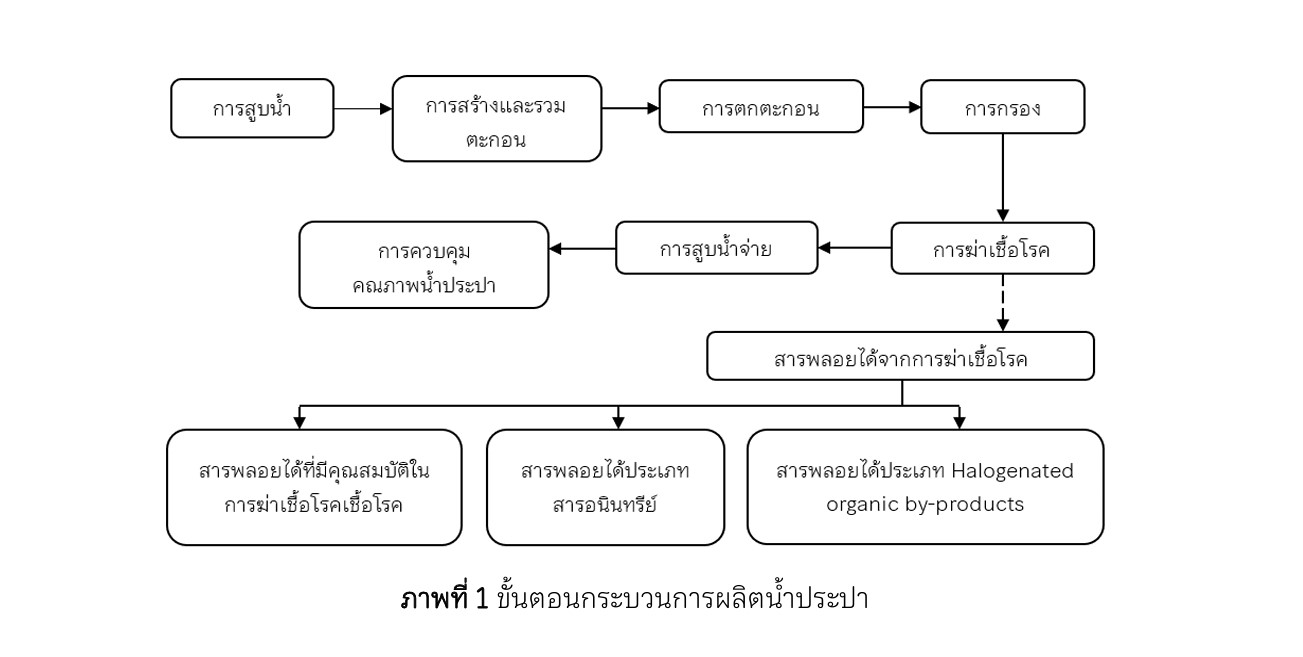The controlling Haloacetic acid formation (HAAs) from chlorine disinfection of water supply system
Keywords:
Haloacetic acids (HAAs), Chlorine disinfection, Water supplyAbstract
The study was collected data from academic articles and research about haloacetic acids for use as improvement and development of water supply system for the better. The haloacetic acids was disinfection by-product formation from chemical reaction between natural organic matter with chlorine. Haloacetic acids concentration depend on 5 factors such as concentration of natural organic matter, concentration of chlorine, temperature, pH and contact times. Haloacetic acids have potentially cause cancer in human, ingestion exposure dermal exposure and inhalation exposure. Therefore must control 5 factors to be appropriate or use technology to direct removal haloaetic acids such as efficiency 90%-100% of membrane to removal.
Downloads
References
ชัยยศ ตั้งสถิตย์กุลชัย. (2554). กระบวนการดูดซับสาร. นครราชสีมา. สำนักพิมพ์มหาวิทยาลัยเทคโนโลยีสุรนารี.
ประพัฒน์ เป็นตามวา. (2555). การประปาชุมชนเมืองและชนบท. นครราชสีมา. ศูนย์บรรณสารและสื่อการศึกษามหาวิทยาลัยเทคโนโลยีสุรนารี.
พงศ์ธร แสงชูติ. (2560). การกำจัดกรดฮาโลอะซิติก (HAAs) ในน้ำประปาด้วยกระบวนการสร้างและรวมตะกอนร่วมกับการดูดซับด้วยถ่านกัมมันต์. วิทยานิพนธ์วิศวกรรมศาสตรมหาบัณฑิต สาขาวิชาวิศวกรรมสิ่งแวดล้อม, มหาวิทยาลัยเทคโนโลยีสุรนารี.
มัลลิกา ปัญญคะโป และ ผ่องศรี เผ่าภูรี. (2550). รายงานการวิจัยเรื่องการเกิดสารไตรฮาโลมีเทนในน้ำประปาที่ผ่านการฆ่าเชื้อโรคด้วยคลอรีน กรณีตัวอย่างระบบประปาของเทศบาลนครนครปฐม. ภาควิชาวิทยาศาสตร์สิ่งแวดล้อม, มหาวิทยาลัยศิลปากร.
Babi, K. G., Koumenides, K. M., Nikolaou, A. D., Makri, C. A., Tzoumerkas, F. K., & Lekkas, T. D. (2007). Pilot study of the removal of THMs, HAAs and DOC from drinking water by GAC adsorption. Desalination, 210(1-3), 215-224.
Bond, T., Goslan, E. H., Parsons, S. A., & Jefferson, B. (2012). A critical review of trihalomethane and haloacetic acid formation from natural organic matter surrogates. Environmental Technology Reviews, 1(1), 93-113.
Cheema, W. A., Kaarsholm, K. M., & Andersen, H. R. (2017). Combined UV treatment and ozonation for the removal of by-product precursors in swimming pool water. Water Research, 110, 141-149.
Chuang, Y.-H., Wang, G.-S., & Tung, H.-H. (2011). Chlorine residuals and haloacetic acid reduction in rapid sand filtration. Chemosphere, 85(7), 1146-1153.
Dmitruk, U. & Dojlido, J. (2007). Haloacetic acids (HAAs) in the central waterworks in Warsaw, Poland. Polish Journal of Environmental Studies, 16(1), 51-56.
Ghomshe, S. T., Mousavi, S., Soltanieh, M., & Kordi, A. S. (2011). Batch and column study of haloacetic acids adsorption onto granular activated carbon. Scientific Research and Essays, 6(16), 3553-3560.
Ghomsheh, S. M., Soltanieh, M. O. H. A. M. M. A. D., and Mosavi, M. A. H. M. O. D. (1790). Overview of the separation and removal of haloacetic acids in drinking water. Advances in waste management. 1146-1153.
Guay, C., Rodriguez, M., & Sérodes, J. (2005). Using ozonation and chloramination to reduce the formation of trihalomethanes and haloacetic acids in drinking water. Desalination, 176(1-3), 229-240.
Lu, J., Zhang, T., Ma, J., & Chen, Z. (2009). Evaluation of disinfection by-products formation during chlorination and chloramination of dissolved natural organic matter fractions isolated from a filtered river water. Journal of Hazardous Materials, 162(1), 140-145.
Marhaba, T., & Washington, M. (1998). Drinking water disinfection and by-products: history and current practice. Advances in Environmental Research, 2(1), 103-115.
Nikolaou, A., Lekkas, T., & Golfinopoulos, S. (2004). Kinetics of the formation and decomposition of chlorination by-products in surface waters. Chemical Engineering Journal, 100(1-3), 139-148.
Palumbo, D. J., Andreola, R., Utida, M. A., Teixeira, T. M., Schmidt Filho, E., de Oliveira, J. R., & Fernandes, V. T. (2018). Analysis of haloacetic acids (HAA5) in waters of public schools and residencies in Maringá-Brazil. Journal of Water Resource and Protection, 10(11), 1083-1089.
Ratasuk, C. H. A. L. A. T. I. P., Ratanatamskul, C. H. A. W. A. L. I. T., & Ratasuk, N. O. P. A. W. A. N. (2009). Removal of haloacetic acids by nanofiltration. Journal of Environmental Sciences, 21(1), 96-100.
Ratasuk, C., Kositanont, C., & Ratanatamskul, C. (2008). Removal of haloacetic acids by ozone and biologically active carbon. ScienceAsia, 34(3), 293-298.
Rodriguez, M. J., Serodes, J., & Roy, D. (2007). Formation and fate of haloacetic acids (HAAs) within the water treatment plant. Water Research, 41(18), 4222-4232.
Saengchut, P., Karuchit, S., & Pentamwa, P. (2018). Investigation of haloacetic acids (HAAs) levels in water supply and its correlated HAAs formation. IOP Conference Series: Earth and Environmental Science, 164, 012023.
Tsitsifli, S., & Kanakoudis, V. (2018). Disinfection impacts to drinking water safety—a review. Proceedings, 2(11), 603.
Uansiri, S. (2009). Determination of Haloacetic Acids in Water Samples Using Ion Chromatography. Master of Science Chemistry, Mahasarakham University.
US.EPA. (2012). EPA Drinking Water Guidance on Disinfection By-Products In nd (Ed.), Disinfection By-Products in Drinking Water (2nd ed.). United Kingdom.
WHO. (2006). Guidelines for drinking-water quality. 3rd ed. Vol. 1 Recommendations: Switzerland.

Downloads
Published
How to Cite
Issue
Section
License
Copyright (c) 2024 Nakhon Ratchasima Rajabhat University

This work is licensed under a Creative Commons Attribution-NonCommercial-NoDerivatives 4.0 International License.



